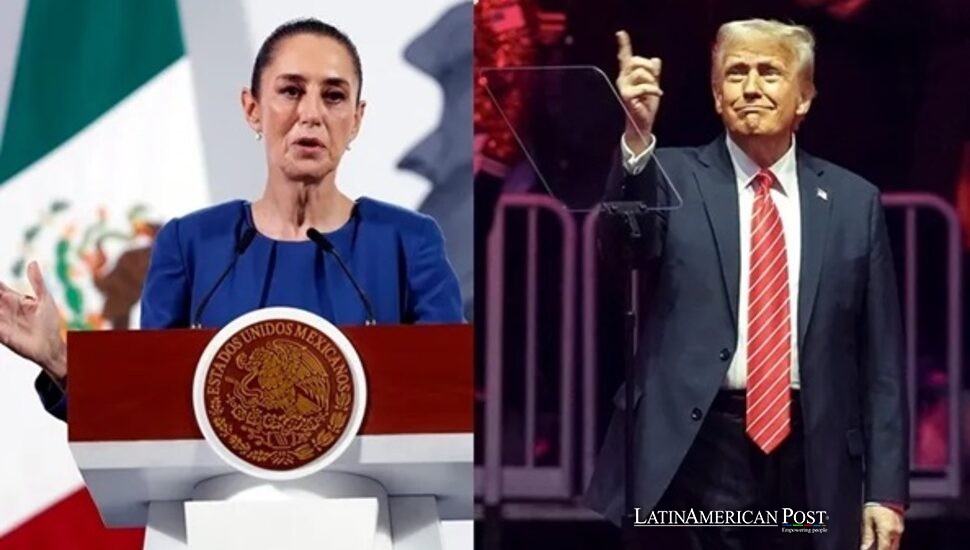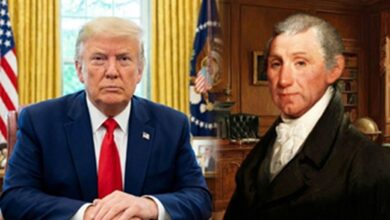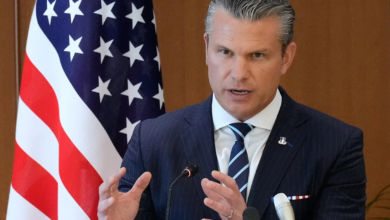Mexico Secures Urgent Trump Pact to Postpone Tariff Imposition

In a last-minute deal, Mexican President Claudia Sheinbaum announced Monday that the United States and Mexico have temporarily averted a damaging tariff standoff. The agreement postpones President Trump’s planned 25% tariffs by at least a month, averting immediate economic fallout.
A Tenuous Month-Long Reprieve
Mexico’s sudden break from U.S. tariffs came after two days of pressure and open warnings. The situation led to quick discussions between Mexican President Claudia Sheinbaum and U.S. President Donald Trump on Monday morning. The talks affected billions in trade between borders and future relations across North America. A swirl of competing interests—migration, narcotics trafficking, and tariffs—converged in a moment that might decide the near-term future of the Mexican economy.
A post on the X platform confirmed that Sheinbaum and Trump reached an agreement to prevent the 25 % tariffs Trump had threatened on Mexican imports to the U.S. The initial details remained limited, but Sheinbaum revealed her administration’s commitment to station 10,000 National Guard troops at Mexico’s northern border. This plan addresses Trump’s worries about illegal migration or drug flows into U.S. territory.
The earlier Trump statements caused market shifts across nations. He said he would add heavy taxes on products from Mexico, Canada, and China because of the lack of help against drugs or migrants. The White House mentioned these taxes would stay “until the crisis ends” without a set date. A short pause from taxes helped Mexico, but the one-month break shows that trade links face risk.
Mexico gained success by stopping a fast economic break that risked a crisis. But the deal stays uncertain: if Trump views Mexico’s actions as weak ‒ about drug groups or migrant stops ‒ he stands ready to put the 25 % tax in place as promised. The precarious nature of this arrangement raises questions about what happens when the month-long grace period lapses and whether Mexico can realistically sustain a heightened security posture along the border.
Trade Tensions Escalate on Multiple Fronts
The weekend led to a wave of tariff notices from Trump, who showed his readiness to use trade limits as a lever against other countries. In addition to threatening Mexico with a 25% import duty, he also targeted Canada with responsibilities at the same rate, explicitly singling out Canadian goods and a 10% rate on Canada’s energy products. Trump insisted that both Mexico and Canada bear responsibility for what he describes as unchecked migration and a surge of narcotics, particularly fentanyl, into the United States.
Trump’s executive orders contradicted a free trade pact he signed in 2020—an agreement he once touted as “the fairest, most balanced and beneficial trade agreement we have ever signed into law.” The proposed tariffs on U.S. neighbors would amount to a drastic reversal of that celebratory stance. Coupled with a 10% levy on all Chinese imports, the White House plan threatened to ignite a tripartite economic dispute.
Although Trump has long used tariffs to influence trade negotiations, many economists and industry leaders worry that this new round of duties extends beyond typical bargaining tactics. They are concerned that a wide-ranging trade war could damage industries on all sides of the border—auto manufacturing, agriculture, electronics, and consumer goods would all face higher costs. American consumers, too, might see prices rise on everything from avocados and cars to televisions and refrigerators.
Moreover, U.S. officials’ statements that these tariffs would continue “until the crisis is alleviated” offer little clarity regarding benchmarks or timelines. Trump repeatedly insisted that “nothing” would deter him from imposing duties, implying that changes to immigration or drug enforcement in Mexico must be swift and dramatic. The persistent uncertainty leaves companies scrambling to adapt their supply chains and budget for the possibility of steep new costs.
Mexico, Canada, and China wasted no time responding. The three nations vowed to retaliate with duties on American imports or possible consumer boycotts. Canadian Prime Minister Justin Trudeau spoke against Trump’s reasoning and dismissed links between Canada and U.S. problems with migration and fentanyl. Trudeau also announced two tariffs on various U.S. goods, calling on Canadians to avoid American-made products, illustrating how quickly trade disagreements can escalate into broader consumer-level disputes.
Mexico’s High-Stakes Balancing Act
While Canada and China voiced their readiness for retaliation, Mexico found itself especially precarious. The United States receives 83 % of Mexican exports in a bilateral trade relationship worth $800 billion annually. A 25 % tariff would cause severe economic damage to Mexico. This action could push Mexico toward recession along with a peso drop against the dollar or less foreign investment.
A weaker Mexican economy opposes Trump’s aims to cut migration and drug trafficking. Past evidence shows that economic problems lead to both issues: people who become unemployed or earn less money often attempt to cross borders. Drug organizations take advantage of unstable conditions to expand control. As a result, some analysts describe the threatened tariffs as a self-defeating measure that, if enacted, could worsen the very issues Trump aims to resolve.
President Sheinbaum spoke about this conflict. The politician reacted to the White House statements last weekend by pointing out Mexico’s direct actions against drug crime along with its efforts to dismantle trafficking groups. In only four months since her administration began, she claims that Mexican authorities have seized over 40 tons of illegal drugs, including 20 million fentanyl doses, and arrested more than 10,000 suspects tied to organized crime. Such numbers serve to rebut the White House’s assertion that the Mexican government “maintains an intolerable alliance” with drug cartels.
Still, Sheinbaum faces tight constraints in how far she can push back. The scale of Mexico’s integration with the U.S. economy leaves little doubt: a trade war would likely hit Mexico much more complex than the United States. Recognizing this, Sheinbaum took to social media to clarify that while she prefers dialogue and collaboration, she will match tariffs “tit for tat” if the U.S. imposes them. A careful balance exists as she aims to protect Mexico’s independence without starting an economic dispute.
Mexico faces problems with weapons from the United States. Sheinbaum points out that many firearms cross the border each year or fuel the violence Trump speaks about. She believes the U.S. must address drug use along with stopping gun flow into Mexico to reduce cartel strength. The pattern of drugs moving northward as guns move southward shows how complex the border issues are – a problem tariffs alone cannot fix.
The experts say Sheinbaum needs local backing to handle Trump’s requirements. Mexican citizens take pride in leaders who resist U.S. pressure. However, her support could decrease if her government fails to stabilize the economy, even with bold statements. The coming month—during which the threat of tariffs looms—will be a severe test of her diplomatic skills and economic management.
Toward a Fragile Path Forward
While Monday’s accord offers breathing room, nobody in Mexico City or Washington harbors illusions of a permanent resolution. The agreement sets a one-month pause on tariffs. Mexico must show its border controls stop enough migrants or drugs to satisfy Trump. If Mexico fails, a 25 % tax will start with no new talks.
U.S. officials and Mexican leaders are now creating ways to measure success. A plan will count stopped migrants at borders, seized drugs, or the amount of shared intelligence. Yet the notion that a single month can reverse entrenched structural problems—like poverty driving migration or the deep roots of cartel networks—seems overly optimistic to many experts. Nonetheless, the White House might insist on visible symbolic actions, such as high-profile raids or stepped-up military patrols, as proof of Mexico’s resolve.
The unstable setup affects businesses on both sides of the border. Companies need time to change their supply chains and processes, especially in automobile manufacturing. Vehicle components move back and forth across borders many times until they reach the final assembly. A number of businesses have started keeping extra parts or products to protect themselves from unexpected increases in tariffs. Others are accelerating efforts to diversify, seeking suppliers outside North America, though shifting large portions of complex manufacturing is neither cheap nor straightforward.
Moreover, the uproar extends to agriculture. American farmers, who have already endured retaliatory tariffs from China, can lose access to key export markets if Mexico responds in kind. Mexico is a significant buyer of U.S. agricultural products, from corn to soybeans to dairy. Should Mexican consumers face higher prices or boycott American goods, the shockwaves could reverberate across American farm states heavily dependent on trade.
The threat of deeper conflict with Canada and China only adds to the uncertainty. Trudeau’s statement to reject blame for U.S. immigration or fentanyl problems shows frustration among America’s trade allies. Canada’s plans for countermeasures, along with China’s possible actions, could turn this dispute from a U.S.-Mexico issue into a broader trade conflict. This result would put Trump’s claim to the test that other nations need the United States more than it needs them.
The markets showed mild relief after Mexico’s announcement and the peso’s slight recovery from its lowest point in three years. However, experts warn that this calm period may not last if basic problems continue. A tweet from Trump or conflicts about border control could make things worse. Businesses that depend on border trade must stay alert because each new problem creates uncertainty for their plans.
The social effects matter just as much as trade numbers or currency rates. As experts predict, a Mexican economic downturn could lead more people to leave the country. Stricter border controls can create human rights issues when people who seek asylum get stuck between countries. Drug groups adapt quickly to new rules by finding different routes or switching to other goods.
This scenario underlines the paradox at the heart of Trump’s tariff approach: the president wields economic pain as a bargaining chip to force policy changes, yet applying that pressure can produce the conditions—unemployment, instability, frustration—that accelerate migration and drug traffic. Critics of Trump’s methods argue that diplomatic cooperation and targeted programs tackling the root causes of migration would be more effective than broad tariffs. Proponents counter that only the threat of severe financial punishment compels foreign governments to act.
For her part, President Sheinbaum contends that punitive measures ultimately undermine the mutual interests both nations share. She has urged a “problem-solving” approach focused on open communication, intelligence sharing, and addressing social factors that feed narcotics demand. She also notes that addressing the U.S. appetite for illegal drugs must be central to any serious strategy. Meanwhile, American officials stress that the White House applies consistent leverage to ensure compliance.
Whether this standoff will evolve into a cooperative framework or devolve into acrimonious back-and-forth tariffs remains uncertain. Much hinges on the next 30 days, during which Mexico must convince Trump it is meeting his demands. Diplomacy could still avert a clash that might devastate Mexico’s already fragile economy—an event that would undoubtedly compound the “crisis” fueling Trump’s actions.
If the month passes without further escalation, Sheinbaum might solidify her standing as a president able to navigate the tempestuous waters of U.S.-Mexico relations. If not, Mexico will confront a tough choice: comply more fully with Trump’s hardline requests or adopt a confrontational stance, risking a recession that experts say would drive unemployment, fuel organized crime, and intensify the exodus of migrants to the United States. In such a scenario, the claimed solution becomes a generator of the problems it aims to fix.
At the core of a delicate balance lies the question of sovereignty. Trump demands decisive Mexican action against drugs and migration, but Sheinbaum takes offense at the White House’s approach, which she sees as domineering and blind to Mexico’s results. She opposes claims that her government works with cartels and points to major drug seizures and numerous arrests. Yet practical power dynamics do not favor her bargaining position: America’s massive economy can absorb tariff disruptions more easily than Mexico, leaving Sheinbaum to negotiate from a weaker hand.
Observers suggest that if a long-term resolution is to be found, the root causes behind migration and drug trafficking must be tackled systematically. For instance, improving economic opportunities in Mexico’s rural heartlands and Central America could stem the flow of migrant caravans. Collaboration on intelligence and arms interdiction might begin to undercut cartels’ operational capacities. The focus of Trump and Sheinbaum remains on quick fixes like tariffs or border forces instead of creating lasting partnerships.
After Monday’s statement, a clear point emerges: Mexico’s reliance on U.S. trade puts it in a difficult spot with few options. A single month may not prove enough to meet Trump’s demands. Business leaders, farmers, and consumers are now preparing for more instability. Each day that lacks agreement deepens the divide between both nations. A choice between cooperation or economic hardship stays uncertain.
Also Read: Mexico Fights Trump’s Tariffs Amid Fierce Border Tensions
Mexico faces extreme risks. A breakdown of the delicate agreement could send shocks through generations, destabilizing an economy close to failure. The United States takes heavy risks as well. Hampering Mexico’s stability risks fueling exactly the challenges—drug trafficking and migration—that Trump cites as justification for tariffs. If negotiation fails, the uneasy peace that Sheinbaum and Trump have achieved for a month could dissolve into the chaos they claim to want to avoid.





